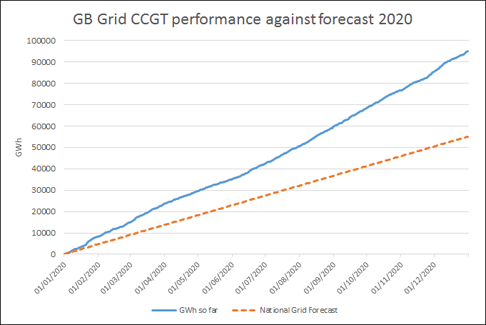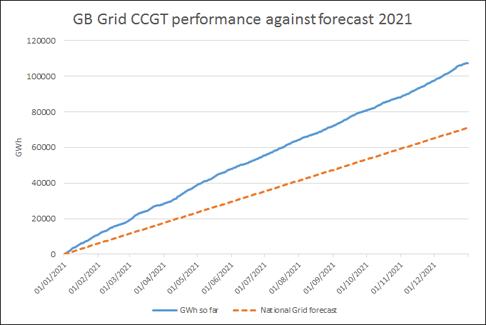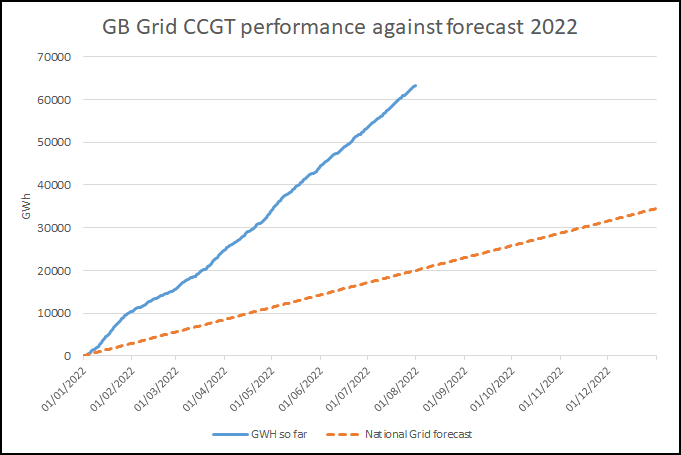Electricity generation in GB using CCGT Gas
One of the cornerstones of reducing emissions and ultimately achieving net zero in GB is rapid reduction in the use of CCGT Gas to generate electricity.
For the last few years CCGT Gas has been the main dispatchable source that has dealt with variations in renewables - notably wind - but with the forecast increase in wind capacity and generation the National Grid ESO has still been expecting CCGT Gas generation to decrease and then become unnecessary.
However, the National Grid ESO's forecasting has been totally at odds with what is actually happening, and the prospects for the elimination of CCGT Gas for electricity generation - and the consequences for emissions - look extremely poor.
The forecasts we use here are contained in the FES documents for the years referred to, and in particular the relevant data workbooks.
The reported performance in each case is from the Elexon site, which is the official reporting source for the GB National Grid.
What happened in 2020?
The chart shows two lines.
In FES 2019 the 5 year forecast for CCGT Gas generation for the Grid in 2020 was 55.0TWh, with declining generation forecast for later years including 41.6TWh in 2022.
The total generated was almost 95TWh, i.e. almost double the forecast.
The dashed red line in the chart on the right shows the forecast generation using CCGT Gas for the year levelised over the year, i.e. representing how a plot of the generation would look if it were evenly spread over the year.
The blue line shows the actual generation over the year. CCGT generation exceeded forecast throughout the year, achieving the total forecast by National Grid ESO on 16 August 2020.

What happened in 2021?
Despite what was supposed to be a downward trend in the use of CCGT Gas, in FES 2020 the 5 year forecast for CCGT Gas generation in 2021 was set at the higher figure of 71.02 TWh, whilst the forecast for 2022 was increased from 41.6TWh to 61.08TWh, an increase of almost 50%.
However, the actual total CCGT generation for the year in 2021 was over 107.2TWh. Actual generation reached the forecast 71.02TWh on 28 August 2021.
In 2021 total generation from CCGT Gas for the GB Grid exceeded the total for 2020, although of course part of this should be attributed to the COVID pandemic.

What's happening in 2022?
Despite consistently exceeding forecasts for generation using CCGT Gas, in FES 2021 National Grid ESO drastically reduced the forecast for 2022 to 34.43TWh. Forecasts for later years were also slashed to much lower figures.
Given the obvious failure to achieve any of the recent forecasts for the reduction in the use of CCGT Gas, why did the National Grid ESO decide to make such totally unrealistic forecasts?
As we are only part way through 2022 we do not yet know what the total for the year will be, but that figure of 34.43TWh was passed on 2 May 2022.

Something strange happened later in 2022.
FES 2022 was published on 18 July. Its forecast for 2022 was 55.74TWh, a figure that had already been passed by the day of publication.
And by mid-August 2022, generation from CCGT Gas was running ahead of generation for 2021.
The chart shows both CCGT use in 2021 and 2022 and the two forecasts for 2022.
Given the reductions in generation forecast, why is it actually increasing year on year?
On a more realistic note, however, the forecast for 2023 is 95.41TWh in FES 2022. It does not bode well for GB emissions, but it does seem rather more realistic than earlier forecasts.
Why is the modelling and forecasting done by National Grid ESO so wrong?
Why do they not learn from their own recent mistakes?
What is the point of making such totally unrealistic forecasts?
Is it only to make it look as though GB's emissions targets are achievable?